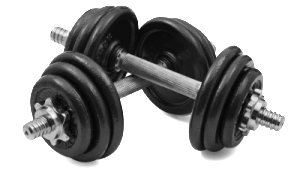
Research shows that approximately 40% of individuals make a New Year’s Resolution. Almost all resolutions are tied to health in some way. This is the perfect opportunity to make strides toward a healthier “YOU” in 2015. The New Year brings a fresh start. At

Here are a few to get you started. We will continue the list in our next installment:
1. Don’t Do Cardio!
People often mistakenly think cardio exercises like running and machine exercises are best for burning calories and fat. This is because the calories burned during exercise are usually higher with these than with heavy weight lifting. But what happens after the workout is what matters most. Everyone knows that lifting builds lean muscle, which drives up your daily resting energy expenditure. This is the primary mechanism fueling your metabolism. Weight training with the largest muscle groups elevates post-workout energy expenditure significantly more than steady-state cardio due to the metabolic stress it causes. In a study that compared cardio with moderate weight lifting, the moderate weight lifting burned double the calories in the 24 hours after the exercise than cardio did.
2. Do high intensity training (HIT) or an interval workout.
Sprint intervals or HIT with short rest periods can raise post-workout energy expenditure even more than traditional training. For example, in the 22 hours after trained men did a special HIT protocol of 9 sets per exercise of leg press, chest press, and pull downs, they burned an extra 452 calories. A traditional training program of 4 sets to failure had trainees burn an extra 98 calories in the post-workout period.
Here are a few key points to consider when designing HIT or sprint workouts that raise metabolic rate:
- Use work bouts that last between 20 and 60 seconds, allowing you to preserve peak effort.
- Use short rest intervals ranging between 10 and 60 seconds.
- Do enough work bouts so that the body starts producing lactic acid, but not too many so that you can’t recover – most HIT workouts should be done in less than 25 minutes.
3. Do a single maximal effort sprint.
Just one all-out sprint has the power to significantly raise metabolic rate and protect your health. For example, a recent study found that a single extended 2-minute all-out sprint improved insulin sensitivity and increased energy expenditure for the 24 hours after the workout in overweight men. Fat oxidation was also increased by 38 percent, which is a favorable metabolic state in overweight people who typically have a reduced ability to use fat for energy. To get the metabolic boost, try jumping rope for 2 minutes or do 30 pushups in 30 seconds. Needless to say, that workout time is intense but doable. The metabolic boost is worth it if you have little time to devote to training or simply don’t like to exercise.
Please check back Thursday as we explore the ways diet can contribute to your metabolic boost.
We have some fantastic opportunities for learning in 2015. Please sign up at the front desk of our Roanoke, Virginia office. For class updates, healthy tips, and office information, follow us on Facebook and Twitter @CoreRoanoke. Or call our office directly at 1-540-344-1055.
Upcoming classes:
Thyroid Disorders and Boosting Your Metabolism – January 15 @ 6pm
[LivFit] Nutrition and Exercise Seminar Series – February 12, 19, 26 @ 6pm
Dr. Daryl Rich, DC, CSCS







